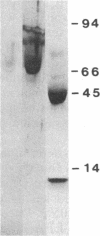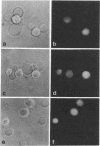Abstract
The recognition of foreign antigen by T lymphocytes requires direct contact with cells expressing the antigen. It has recently become clear that T lymphocytes can form conjugates with other cells in the absence of foreign antigen expression. Studies using monoclonal antibodies (mAbs) to inhibit conjugate formation have suggested that a portion of the antigen-dependent adhesion is mediated by T lymphocytes interacting with cells expressing lymphocyte-function-associated antigen 3 (LFA-3), a widely distributed cell surface protein. We have investigated antigen-independent adhesion by incorporating affinity-purified LFA-3 into the lipid membrane of an artificial target cell (ATC; a nylon-matrix vesicle with a lipid membrane). These vesicles are similar in size and density to intact cells, so that conjugates between cells and ATCs may be seen by light microscopy. ATCs expressing a density of LFA-3 similar to that on intact cells were found to form conjugates with T cells, but only if the T cells expressed the sheep erythrocyte receptor, CD2 (T11; LFA-2). Previous studies using mAbs have implicated the CD2 molecule in both adhesion and T-cell activation. ATCs prepared without surface protein or with purified HLA class I protein failed to interact with the CD2-positive T cells, indicating that the adhesion found was mediated by the LFA-3 molecule. Furthermore, mAb against LFA-3 or CD2 was able to block the LFA-3-mediated vesicle-cell interaction, whereas mAb against LFA-1 or HLA failed to inhibit the interaction. These results provide direct evidence that LFA-3 functions as an adhesion molecule by serving as a ligand for the CD2 molecule on T cells.
Full text
PDF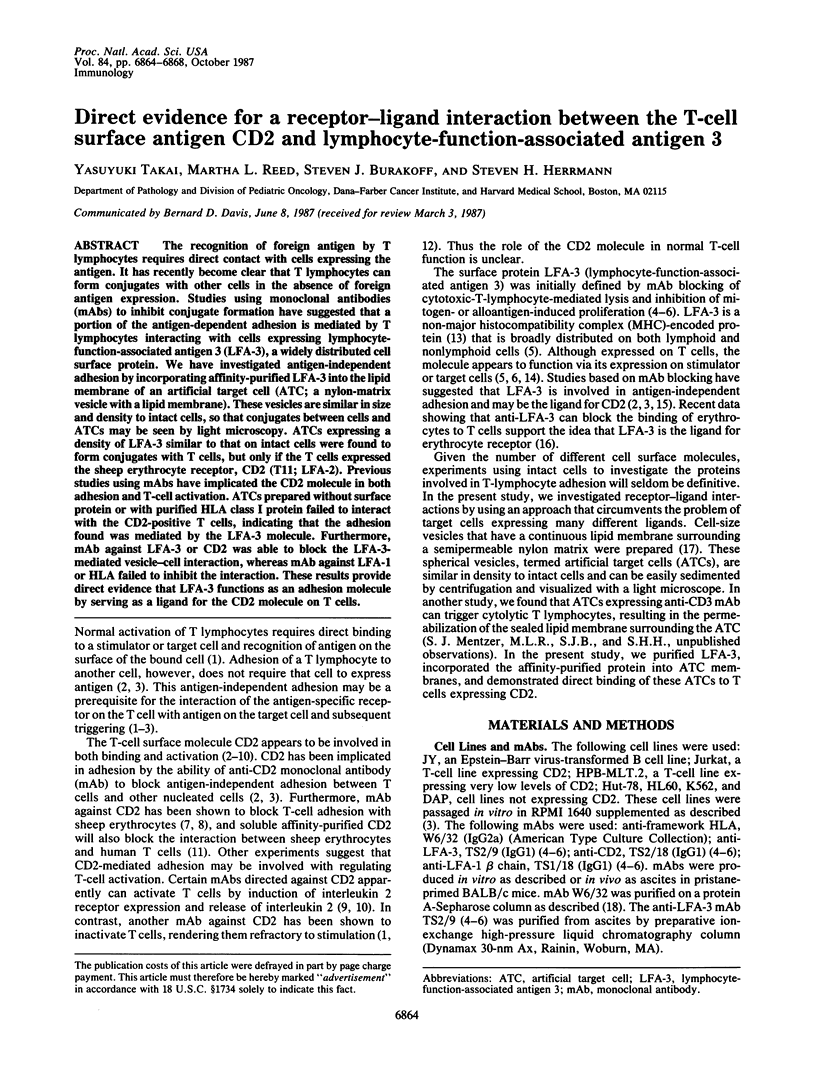
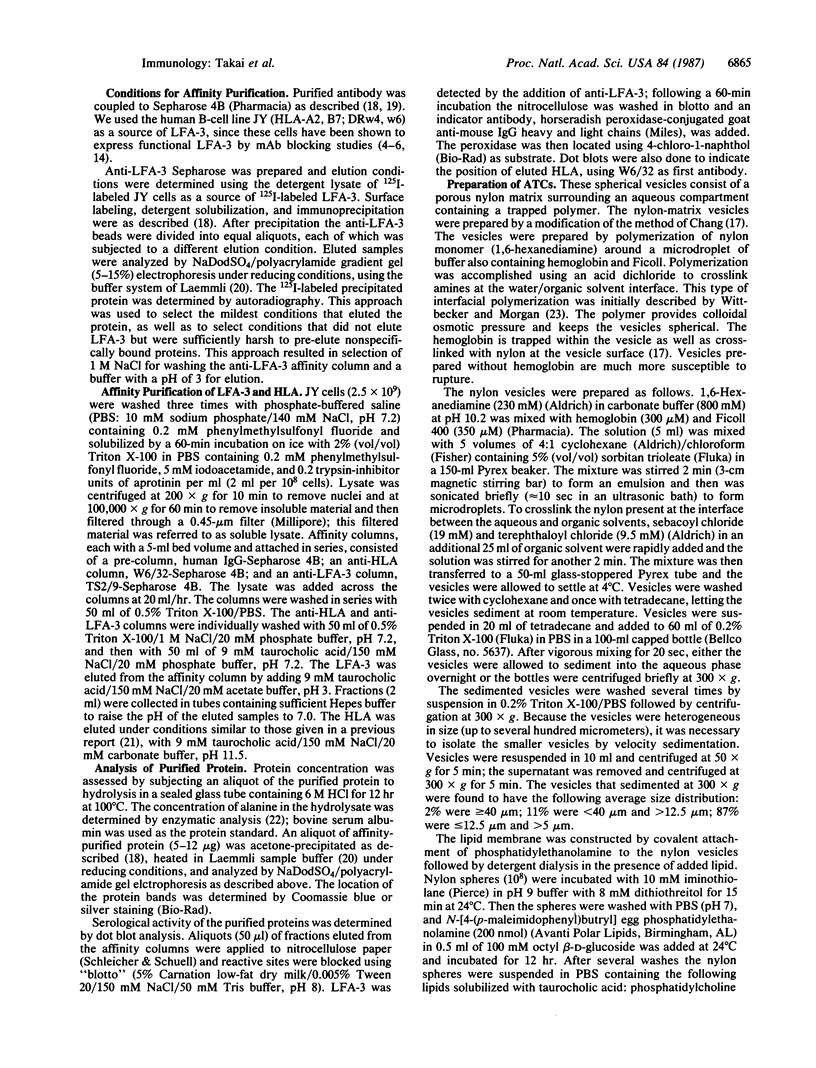
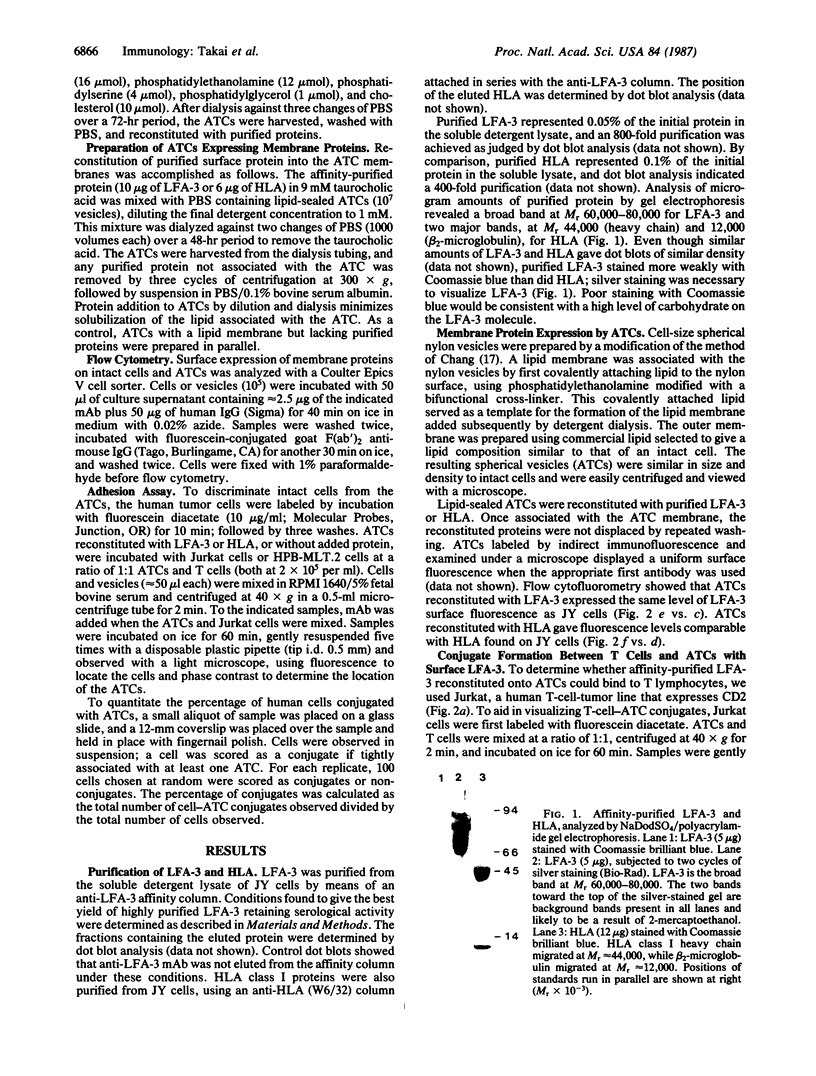
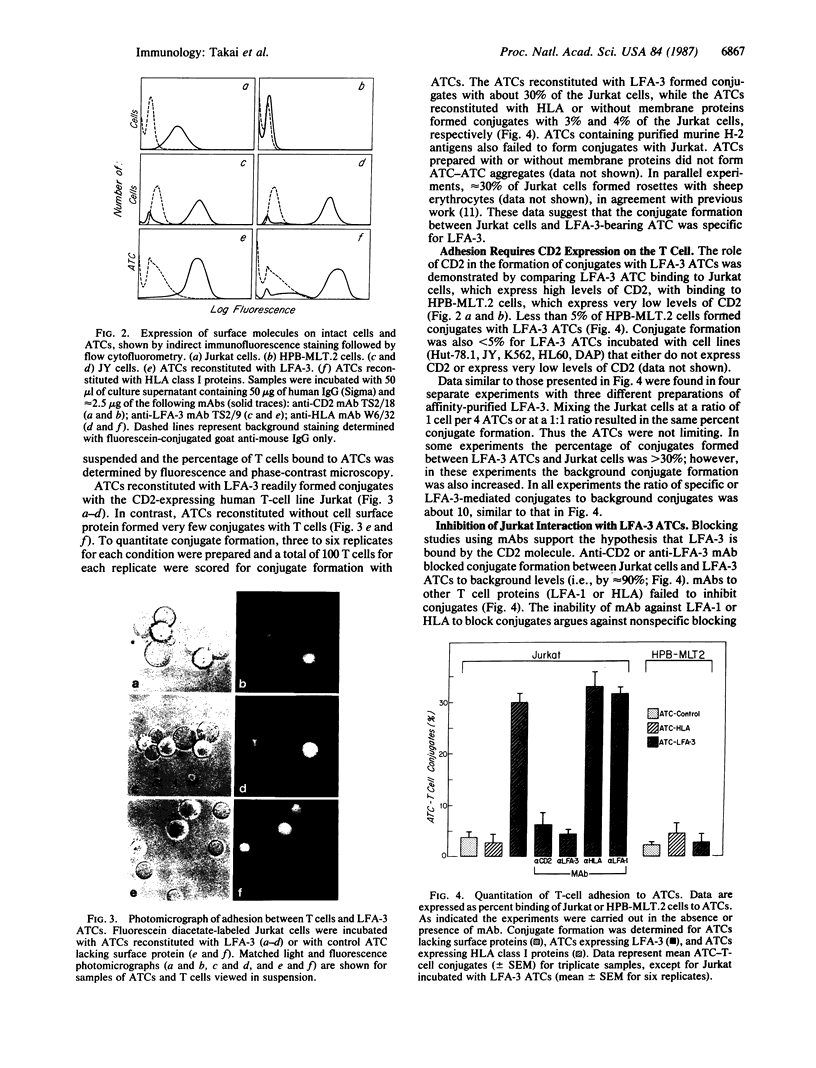
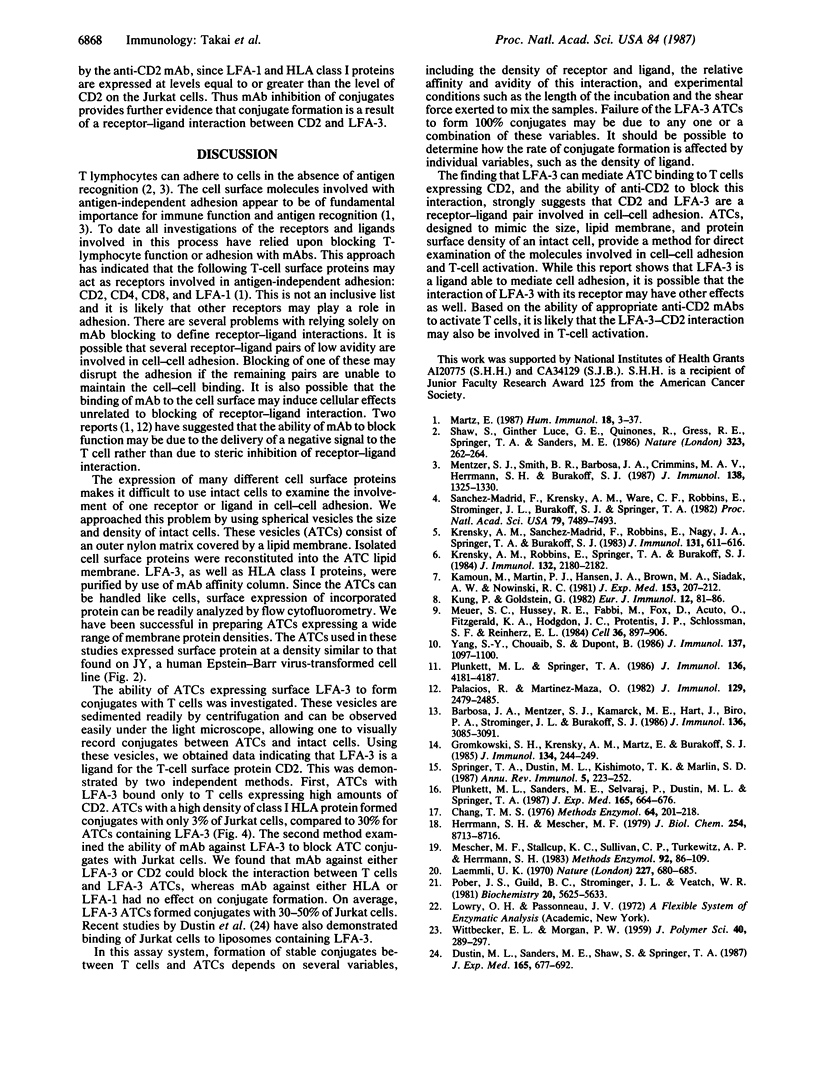
Images in this article
Selected References
These references are in PubMed. This may not be the complete list of references from this article.
- Barbosa J. A., Mentzer S. J., Kamarck M. E., Hart J., Biro P. A., Strominger J. L., Burakoff S. J. Gene mapping and somatic cell hybrid analysis of the role of human lymphocyte function-associated antigen-3 (LFA-3) in CTL-target cell interactions. J Immunol. 1986 Apr 15;136(8):3085–3091. [PubMed] [Google Scholar]
- Chang T. M. Microencapsulation of enzymes and biologicals. Methods Enzymol. 1976;44:201–218. doi: 10.1016/s0076-6879(76)44018-1. [DOI] [PubMed] [Google Scholar]
- Dustin M. L., Sanders M. E., Shaw S., Springer T. A. Purified lymphocyte function-associated antigen 3 binds to CD2 and mediates T lymphocyte adhesion. J Exp Med. 1987 Mar 1;165(3):677–692. doi: 10.1084/jem.165.3.677. [DOI] [PMC free article] [PubMed] [Google Scholar]
- Gromkowski S. H., Krensky A. M., Martz E., Burakoff S. J. Functional distinctions between the LFA-1, LFA-2, and LFA-3 membrane proteins on human CTL are revealed with trypsin-pretreated target cells. J Immunol. 1985 Jan;134(1):244–249. [PubMed] [Google Scholar]
- Herrmann S. H., Mescher M. F. Purification of the H-2Kk molecule of the murine major histocompatibility complex. J Biol Chem. 1979 Sep 25;254(18):8713–8716. [PubMed] [Google Scholar]
- Kamoun M., Martin P. J., Hansen J. A., Brown M. A., Siadak A. W., Nowinski R. C. Identification of a human T lymphocyte surface protein associated with the E-rosette receptor. J Exp Med. 1981 Jan 1;153(1):207–212. doi: 10.1084/jem.153.1.207. [DOI] [PMC free article] [PubMed] [Google Scholar]
- Krensky A. M., Robbins E., Springer T. A., Burakoff S. J. LFA-1, LFA-2, and LFA-3 antigens are involved in CTL-target conjugation. J Immunol. 1984 May;132(5):2180–2182. [PubMed] [Google Scholar]
- Krensky A. M., Sanchez-Madrid F., Robbins E., Nagy J. A., Springer T. A., Burakoff S. J. The functional significance, distribution, and structure of LFA-1, LFA-2, and LFA-3: cell surface antigens associated with CTL-target interactions. J Immunol. 1983 Aug;131(2):611–616. [PubMed] [Google Scholar]
- Laemmli U. K. Cleavage of structural proteins during the assembly of the head of bacteriophage T4. Nature. 1970 Aug 15;227(5259):680–685. doi: 10.1038/227680a0. [DOI] [PubMed] [Google Scholar]
- Martz E. LFA-1 and other accessory molecules functioning in adhesions of T and B lymphocytes. Hum Immunol. 1987 Jan;18(1):3–37. doi: 10.1016/0198-8859(87)90110-8. [DOI] [PubMed] [Google Scholar]
- Mentzer S. J., Smith B. R., Barbosa J. A., Crimmins M. A., Herrmann S. H., Burakoff S. J. CTL adhesion and antigen recognition are discrete steps in the human CTL-target cell interaction. J Immunol. 1987 Mar 1;138(5):1325–1330. [PubMed] [Google Scholar]
- Mescher M. F., Stallcup K. C., Sullivan C. P., Turkewitz A. P., Herrmann S. H. Purification of murine MHC antigens by monoclonal antibody affinity chromatography. Methods Enzymol. 1983;92:86–109. doi: 10.1016/0076-6879(83)92011-6. [DOI] [PubMed] [Google Scholar]
- Meuer S. C., Hussey R. E., Fabbi M., Fox D., Acuto O., Fitzgerald K. A., Hodgdon J. C., Protentis J. P., Schlossman S. F., Reinherz E. L. An alternative pathway of T-cell activation: a functional role for the 50 kd T11 sheep erythrocyte receptor protein. Cell. 1984 Apr;36(4):897–906. doi: 10.1016/0092-8674(84)90039-4. [DOI] [PubMed] [Google Scholar]
- Palacios R., Martinez-Maza O. Is the E receptor on human T lymphocytes a "negative signal receptor"? J Immunol. 1982 Dec;129(6):2479–2485. [PubMed] [Google Scholar]
- Plunkett M. L., Sanders M. E., Selvaraj P., Dustin M. L., Springer T. A. Rosetting of activated human T lymphocytes with autologous erythrocytes. Definition of the receptor and ligand molecules as CD2 and lymphocyte function-associated antigen 3 (LFA-3). J Exp Med. 1987 Mar 1;165(3):664–676. doi: 10.1084/jem.165.3.664. [DOI] [PMC free article] [PubMed] [Google Scholar]
- Plunkett M. L., Springer T. A. Purification and characterization of the lymphocyte function-associated-2 (LFA-2) molecule. J Immunol. 1986 Jun 1;136(11):4181–4187. [PubMed] [Google Scholar]
- Pober J. S., Guild B. C., Strominger J. L., Veatch W. R. Purification of HLA-A2 antigen, fluorescent labeling of its intracellular region, and demonstration of an interaction between fluorescently labeled HLA-A2 antigen and lymphoblastoid cell cytoskeleton proteins in vitro. Biochemistry. 1981 Sep 15;20(19):5625–5633. doi: 10.1021/bi00522a042. [DOI] [PubMed] [Google Scholar]
- Sanchez-Madrid F., Krensky A. M., Ware C. F., Robbins E., Strominger J. L., Burakoff S. J., Springer T. A. Three distinct antigens associated with human T-lymphocyte-mediated cytolysis: LFA-1, LFA-2, and LFA-3. Proc Natl Acad Sci U S A. 1982 Dec;79(23):7489–7493. doi: 10.1073/pnas.79.23.7489. [DOI] [PMC free article] [PubMed] [Google Scholar]
- Shaw S., Luce G. E., Quinones R., Gress R. E., Springer T. A., Sanders M. E. Two antigen-independent adhesion pathways used by human cytotoxic T-cell clones. Nature. 1986 Sep 18;323(6085):262–264. doi: 10.1038/323262a0. [DOI] [PubMed] [Google Scholar]
- Springer T. A., Dustin M. L., Kishimoto T. K., Marlin S. D. The lymphocyte function-associated LFA-1, CD2, and LFA-3 molecules: cell adhesion receptors of the immune system. Annu Rev Immunol. 1987;5:223–252. doi: 10.1146/annurev.iy.05.040187.001255. [DOI] [PubMed] [Google Scholar]
- Verbi W., Greaves M. F., Schneider C., Koubek K., Janossy G., Stein H., Kung P., Goldstein G. Monoclonal antibodies OKT 11 and OKT 11A have pan-T reactivity and block sheep erythrocyte "receptors". Eur J Immunol. 1982 Jan;12(1):81–86. doi: 10.1002/eji.1830120115. [DOI] [PubMed] [Google Scholar]
- Yang S. Y., Chouaib S., Dupont B. A common pathway for T lymphocyte activation involving both the CD3-Ti complex and CD2 sheep erythrocyte receptor determinants. J Immunol. 1986 Aug 15;137(4):1097–1100. [PubMed] [Google Scholar]



